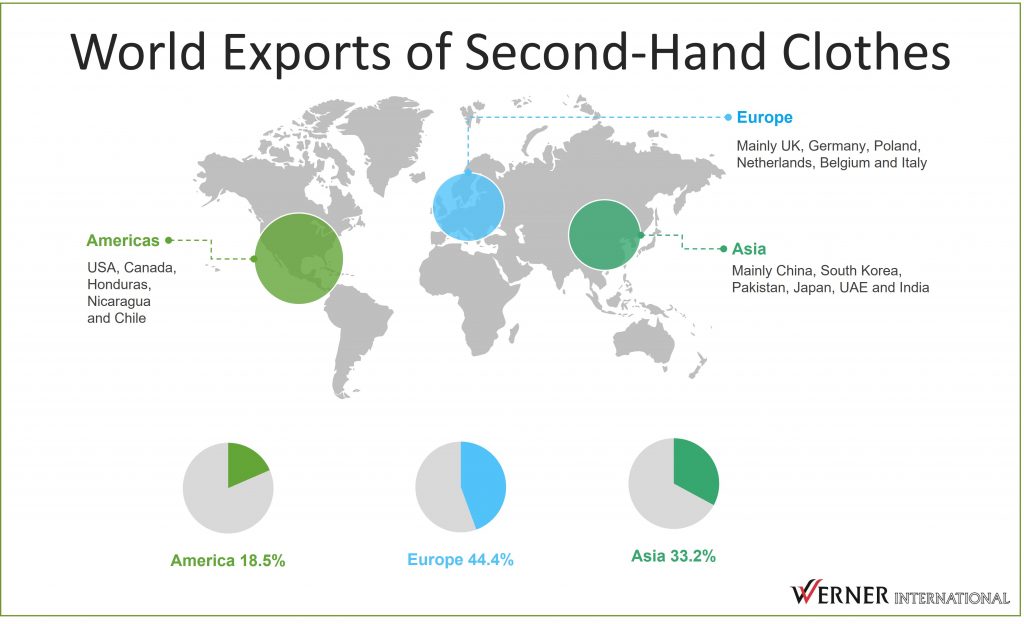The Adventures of Clothing- from second-hand clothes to recycling
History
Secondhand clothing collection and reuse has a long history. In mid and late 19th century, London, Paris and Netherlands were centers for trading of secondhand clothes and the sales were mostly to Europe or Americas. The industry has fluctuated over the 20th century with the evolving economic and political milestones. The end of World War I and II resulted in an oversupply of army clothing which was exported to Africa. Collection of second-hand clothes and small sized exports have long been present but the supply to the collectors grew the most in the 1980s for disaster relief to Africa and other regions with the increase in the humanitarian aid concept. Red Cross and other organizations donated clothes after wars or natural disasters. In the following years, the fall of the Berlin Wall and opening up of the old communist countries brought about a new wave of demand from Eastern Europe for second hand clothing. With growing globalization and less limitations on the world trade the supply and demand further increased to become a 4 billion USD industry globally.
Charitable organizations have been taking part in this industry since the end of the 19th century in Europe and US, however, their share in the industry increased in the 1950s. The charity shops became very active in the 1960s and 1970s and were joined later by other second-hand shops and thrift stores in the 1980s. Towards the end of the 20th century, with the growing consumption of clothing, charities started receiving more supply than they were able to manage so they increased exports and started cooperating more and more with corporations. It is an interesting industry as the collection process is still dominated by the charities and some recycling companies and has economic, social, and environmental aspects to consider.
International Trade of Second-hand Clothes
Giving used clothes a second life and keeping them out of the waste stream is gaining more and more attention and focus in the world. Some countries with higher per capita spending on textiles and apparel are disposing of secondhand clothing in growing amounts and are trying to come up with solutions to stop the environmental affects and the burden on the landfills while other countries with lower per capita spendable income or less local investment in textiles are interested in purchasing secondhand clothes. At the same time, there are textile producer countries that are investing heavily in recycling and need the secondhand clothes or trims to be used as raw material.
The world exports of secondhand clothes totaled 3.9 billion USD as of 2020 with the main exporting markets; US, China, UK, Germany and South Korea making up almost half of the total amount. The importing markets are more fragmented, African imports make up 33.5% (mainly Ghana, Kenya, Tanzania, Cameroon, Congo), European imports 27.7% (mainly Ukraine, Netherlands, Russia and Poland), Asian imports 23.1% (mainly Pakistan, UAE, India and Malaysia), and American imports 9.8% (Guatemala, Nicaragua, Honduras, El Salvador and Canada).
World Exports of Second-hand Clothes
In 2020, The USA was the largest exporter with a total of 622 thousand tons exported, amounting to 613 million USD. The USA exports constituted more than 15% of total world exports in 2020.
Source: ITC calculations based on UN COMTRADE and ITC statistics
In 2020, China was the second largest exporter with 382 million USD followed by UK, Germany and South Korea with 320 million USD, 293 million USD, 289 million USD, total exports respectively, making up almost 50% of the total world exports. Pakistan, Poland, Netherlands, Belgium and Italy follow the lead with 3-5% market shares each. Export prices reflect the quality, usage amount and the careful sorting of the second hand clothes and show differences accordingly.
World Imports of Second-hand Clothes
While the origins of exports of second hand clothes were concentrated at certain geographies, the final destinations are diversified across many countries in the world; 35 countries make up 73% of total imports.
As of 2020 Pakistan is the largest importer of second hand clothes with a share of almost 5%. Pakistan imports totaled 483 thousand tons and 204 million USD in 2020. It is followed by Ghana, Ukraine and UAE with imports of 181 million USD, 157 million USD and 146 million USD and total shares of 4.8% 4.1% and 3.8%, respectively.
Source: ITC calculations based on UN COMTRADE and ITC statistics
At the import destinations around the world, the second-hand clothes are resold through intermediaries for reuse or for recycling.
In the following articles, we will be exploring more on these topics. For more on Werner International New Twist editions please visit https://wernerinternational.com/



